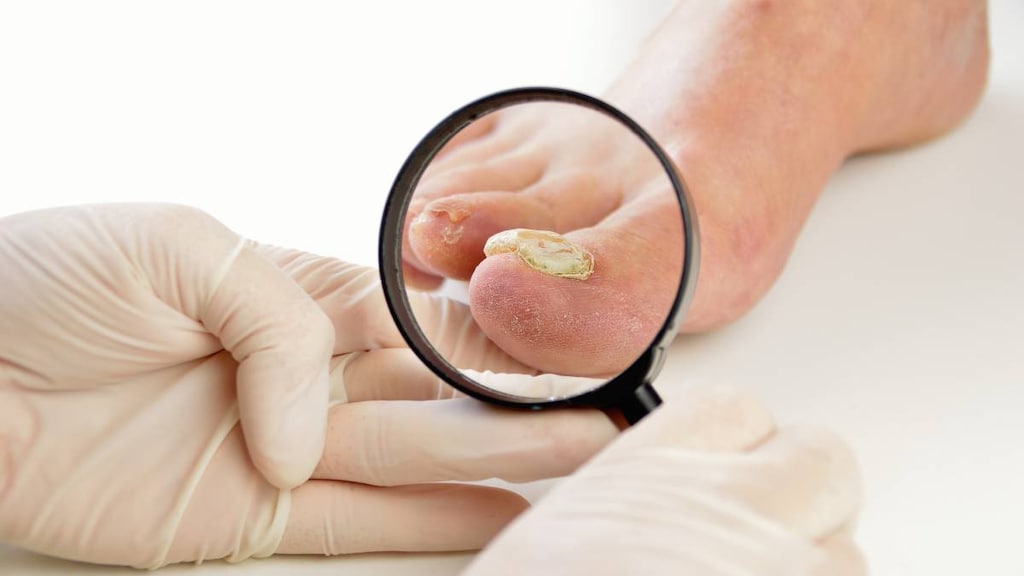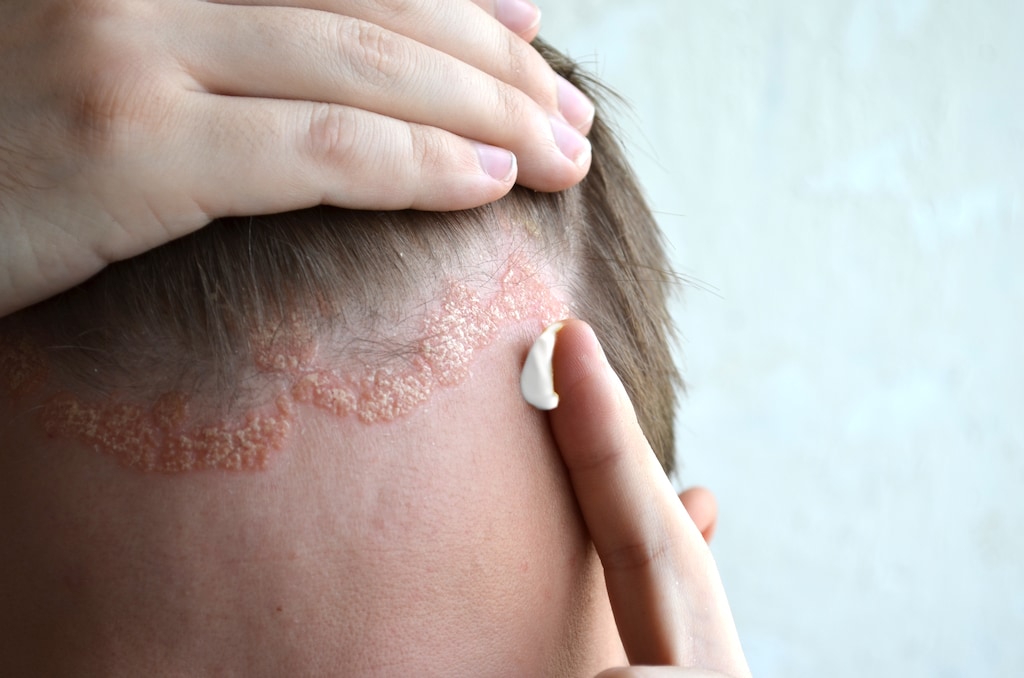Dosage Forms
Excipient information presented when available (limited, particularly for generics); consult specific product labeling.
Foam, External:
Enstilar: Calcipotriene 0.005% and betamethasone dipropionate 0.064% (60 g)
Ointment, External:
Taclonex: Calcipotriene 0.005% and betamethasone dipropionate 0.064% (60 g, 100 g)
Generic: Calcipotriene 0.005% and betamethasone dipropionate 0.064% (60 g, 100 g)
Suspension, External:
Taclonex: Calcipotriene 0.005% and betamethasone dipropionate 0.064% (4 g, 60 g, 120 g)
Generic: Calcipotriene 0.005% and betamethasone dipropionate 0.064% (60 g)
Pharmacology
Mechanism of Action
See individual agents.
Use: Labeled Indications
Plaque psoriasis:
Foam: Treatment of plaque psoriasis in children ≥12 years of age, adolescents, and adults
Gel [Canadian product]: Treatment of mild to moderate plaque psoriasis of the body or moderate to severe psoriasis of the scalp in adults
Ointment: Treatment of plaque psoriasis in children ≥12 years of age, adolescents, and adults
Suspension: Treatment of plaque psoriasis of the scalp and body in children ≥12 years of age, adolescents, and adults
Contraindications
There are no contraindications listed within the manufacturer's labeling.
Canadian labeling: Additional contraindications (not in US labeling): Hypersensitivity to calcipotriene, betamethasone, or any component of the formulation; viral (herpes simplex, varicella, vaccinia), fungal or bacterial infection of the skin; parasitic infections; tuberculosis of the skin; syphilitic skin infections; ophthalmic use; calcium metabolism disorders; perioral dermatitis; atrophic skin; striae atrophicae; fragility of skin veins; ichthyosis; acne vulgaris; acne rosacea; rosacea; ulcers; wounds; perianal and genital pruritus; guttate, erythrodermic and pustular psoriasis; severe hepatic disorders (gel only); severe renal insufficiency (gel only).
Dosage and Administration
Dosing: Adult
Plaque psoriasis: Topical:
Foam: Apply to affected area of skin once daily for up to 4 weeks (maximum dose: 60 g every 4 days).
Gel [Canadian product]: Apply once daily to affected area(s) of body for up to 8 weeks or affected area(s) of scalp for up to 4 weeks. Maximum dose: 100 g/week (including other calcipotriol-containing products). Application to >30% of body surface area (including scalp and body) is not recommended. Following discontinuation, therapy may be reinitiated for recurrence.
Ointment: Apply to affected area of skin once daily for up to 4 weeks (maximum dose: 100 g/week). Application to >30% of body surface area is not recommended.
Suspension: Apply to affected area of skin or scalp once daily for up to 8 weeks (maximum dose: 100 g/week)
Dosing: Geriatric
Refer to adult dosing.
Dosing: Pediatric
Note: Use for shortest amount of time necessary and discontinue therapy once control achieved.
Plaque psoriasis:
Children ≥12 years and Adolescents:
Foam: Topical: Apply to affected area of skin once daily for up to 4 weeks; maximum dose: 60 g every 4 days.
Ointment: Topical: Apply to affected area of skin once daily for up to 4 weeks. Application to >30% of BSA is not recommended.
Maximum weekly dose:
Children ≥12 years and Adolescents ≤18 years: 60 g/week.
Adolescents ≥18 years: 100 g/week. Application to >30% of BSA is not recommended.
Suspension: Topical: Apply to affected area of skin or scalp once daily for up to 8 weeks.
Maximum weekly dose:
Children ≥12 years and Adolescents ≤18 years: 60 g/week.
Adolescents ≥18 years: 100 g/week.
Administration
Wash hands before and after use. Do not apply to face, axillae, or groin or in the presence of preexisting skin atrophy at the treatment site; not for oral, ophthalmic, or intravaginal use. Avoid use of occlusive dressings over treated areas unless directed by a health care provider.
Foam: Shake before use. Rub into affected area gently.
Gel [Canadian product]: Shake bottle before use. If using applicator, assemble per manufacturer instructions (refer to labeling) and then prime before initial use. After priming, the applicator delivers the product in 0.05 g actuations. If applying to the scalp, do not apply within 12 hours of chemical hair treatment. Do not shower/bathe or wash hair directly after use.
Ointment: Rub into affected area gently and completely.
Suspension: Shake well before use. If applying to the scalp, do not apply 12 hours before or after chemical hair treatment. Do not bathe/shower or wash hair directly after use.
Storage
Store at 20°C to 25°C (68°F to 77°F); excursions permitted between 15°C to 30°C (59°F to 86°F). Do not refrigerate suspension, and discard 6 months from date opened. Keep suspension bottle in outer carton when not in use.
Foam: Contents under pressure. Avoid heat, flame, or smoking during use. Do not puncture or incinerate container. Do not expose to heat or store at temperatures >49°C (120°F); do not freeze. Use within 6 months after opening.
Gel [Canadian product]: Store at 15°C to 30°C (59°F to 86°F). Do not refrigerate. Protect bottle from light. Use within 6 months after opening bottle or assembling applicator, or before expiration date.
Drug Interactions
Aldesleukin: Corticosteroids may diminish the antineoplastic effect of Aldesleukin. Avoid combination
Aluminum Hydroxide: Vitamin D Analogs may increase the serum concentration of Aluminum Hydroxide. Specifically, the absorption of aluminum may be increased, leading to increased serum aluminum concentrations. Avoid combination
Calcium Salts: May enhance the adverse/toxic effect of Vitamin D Analogs. Monitor therapy
Cardiac Glycosides: Vitamin D Analogs may enhance the arrhythmogenic effect of Cardiac Glycosides. Monitor therapy
Corticorelin: Corticosteroids may diminish the therapeutic effect of Corticorelin. Specifically, the plasma ACTH response to corticorelin may be blunted by recent or current corticosteroid therapy. Monitor therapy
Deferasirox: Corticosteroids may enhance the adverse/toxic effect of Deferasirox. Specifically, the risk for GI ulceration/irritation or GI bleeding may be increased. Monitor therapy
Hyaluronidase: Corticosteroids may diminish the therapeutic effect of Hyaluronidase. Management: Patients receiving corticosteroids (particularly at larger doses) may not experience the desired clinical response to standard doses of hyaluronidase. Larger doses of hyaluronidase may be required. Consider therapy modification
Hydrocortisone (Topical): May diminish the therapeutic effect of Calcipotriene. Management: Monitor for reduced calcipotriene efficacy if combined with hydrocortisone valerate. Consider separating the administration of these agents by 10 to 12 hours to minimize the risk of this potential interaction. Monitor therapy
Lactic Acid: May diminish the therapeutic effect of Calcipotriene. Management: Monitor for reduced calcipotriene efficacy if combined with lactic acid. Consider separating the administration of these agents by 10 to 12 hours to minimize the risk of this potential interaction. Monitor therapy
Multivitamins/Fluoride (with ADE): May enhance the adverse/toxic effect of Vitamin D Analogs. Avoid combination
Multivitamins/Minerals (with ADEK, Folate, Iron): May enhance the adverse/toxic effect of Vitamin D Analogs. Avoid combination
Ritodrine: Corticosteroids may enhance the adverse/toxic effect of Ritodrine. Monitor therapy
Salicylic Acid: May diminish the therapeutic effect of Calcipotriene. Management: Monitor for reduced calcipotriene efficacy if combined with salicylic acid. Consider separating the administration of these agents by 10 to 12 hours to minimize the risk of this potential interaction. Monitor therapy
Sucralfate: Vitamin D Analogs may increase the serum concentration of Sucralfate. Specifically, the absorption of aluminum from sucralfate may be increased, leading to an increase in the serum aluminum concentration. Avoid combination
Thiazide and Thiazide-Like Diuretics: May enhance the hypercalcemic effect of Vitamin D Analogs. Monitor therapy
Vitamin D Analogs: May enhance the adverse/toxic effect of other Vitamin D Analogs. Avoid combination
Test Interactions
See individual agents.
Adverse Reactions
Also see individual agents.
>10%: Endocrine & metabolic: HPA-axis suppression (≤18%)
1% to 10%: Dermatologic: Pruritus (4% to 7%), psoriasis (2% to 3%), erythema of skin (≤2%), skin atrophy (≤2%), burning sensation of skin (1%), ecchymoses (1%), exfoliative dermatitis (1%), hand dermatosis (1%), skin irritation (1%), folliculitis (≤1%), skin depigmentation (≤1%)
<1%, postmarketing, and/or case reports: Acneiform eruption, acne vulgaris, application site irritation, application site pain, application site pruritus, exacerbation of psoriasis, eye irritation, hypercalcemia, hypercalciuria, hyperpigmentation, papular rash, psoriasis flare, psoriasis (rebound), pustular psoriasis, pustular rash, skin rash, telangiectasia, urticaria, xeroderma
Warnings/Precautions
Concerns related to adverse effects:
- Adrenal suppression: Systemic absorption of topical corticosteroids may cause hypercortisolism or suppression of hypothalamic-pituitary-adrenal (HPA) axis, particularly in younger children, patients receiving high doses for prolonged period, use over large surface areas, under occlusion, or on altered skin barrier, and use in patients with hepatic failure. HPA axis suppression may lead to adrenal crisis and may occur during treatment or after withdrawal of treatment. If HPA axis suppression occurs, an attempt to withdraw the drug, reduce the application frequency, or substitute a less potent corticosteroid. HPA suppression is usually reversible; if glucocorticoid insufficiency occurs, supplemental systemic steroids may be needed.
- Contact dermatitis: Allergic contact dermatitis can occur; it is usually diagnosed by failure to heal rather than clinical exacerbation. Further evaluation (eg, patch testing) may be necessary.
- Hypercalcemia/hypercalciuria: Use with caution in patients with known or suspected disorders of calcium metabolism; may cause transient increases in serum and urinary calcium (reversible); if hypercalcemia or hypercalciuria occurs, discontinue treatment until levels return to normal. The effects on calcium metabolism following treatment durations of longer than 4 weeks (foam, ointment) or 8 weeks (suspension) have not been evaluated.
- Kaposi sarcoma: Prolonged treatment with corticosteroids has been associated with the development of Kaposi sarcoma (case reports); if noted, discontinuation of therapy should be considered (Goedert, 2002).
- Local effects: Local adverse reactions may occur, including atrophy, striae, telangiectasias, burning, itching, irritation, dryness, folliculitis, acneiform eruptions, hypopigmentation, perioral dermatitis, allergic contact dermatitis, secondary infection, and miliaria. These reactions are more likely to occur with occlusive use, prolonged use or use of higher potency corticosteroids; some reactions may be irreversible.
- Ocular effects: Glaucoma and posterior subcapsular cataracts have been reported with topical corticosteroids; avoid contact with eyes and monitor for visual symptoms.
- Systemic effects: Topical corticosteroids may be absorbed percutaneously. Absorption of topical corticosteroids may cause manifestations of Cushing's syndrome, hyperglycemia, or glycosuria. Absorption is increased by the use of occlusive dressings, application to denuded skin, or application to large surface areas.
Disease related concerns:
- Diabetes mellitus: Hyperglycemia and unmasking of latent diabetes mellitus may result from systemic absorption of topical corticosteroids.
- Photosensitivity: Avoid excessive exposure of treated skin to natural or artificial sunlight (eg, tanning booths, sun lamps) and phototherapy.
- Skin infections: Use appropriate antibacterial or antifungal agents to treat concomitant skin infections; if infection persists, discontinue use of calcipotriene and betamethasone until infection has resolved.
Special populations:
- Pediatric: Children may be at higher risk of systemic side effects due to a greater skin surface area:body weight ratio. Children may absorb proportionally larger amounts of corticosteroids after topical application and may be more prone to systemic effects. HPA axis suppression, intracranial hypertension, and Cushing syndrome have been reported in children receiving topical corticosteroids. Prolonged use may affect growth velocity and delay weight gain; growth should be routinely monitored in pediatric patients.
Dosage form specific issues:
- Flammable contents: Foam contains flammable propellants. Avoid fire, flame, and smoking during and immediately following administration.
Other warnings/precautions:
- Appropriate use: Do not use on the face, axillae, groin, or in the presence of preexisting skin atrophy at the treatment site. Not for oral, ophthalmic, or intravaginal use. Avoid exposure of suspension to the eyes; irritation may occur. Do not use occlusive dressings unless directed by a health care provider; discontinue use if irritation occurs.
Monitoring Parameters
Baseline serum calcium levels and then periodically during treatment in patients at risk for hypercalcemia
Pregnancy
Pregnancy Considerations
The treatment of psoriasis in pregnancy is initiated with conservative treatment as in nonpregnant females. When a topical steroid is needed, low to moderate potency corticosteroids are preferred initially, followed by moderate to high potency agents. High potency topical steroids should be used only when clearly needed and after the first trimester (Bae 2012). Information related to the use of calcipotriene in pregnancy has not been located (Bae 2012; Bangsgaard 2015); until additional information is available, some sources do not recommend use in pregnant females with psoriasis (Bae 2012), while others recommend limiting exposure to ≤50 g/week for ≤3 to 4 weeks) (Rademaker 2018).
Also refer to the Betamethasone (Topical) monograph for additional information.
Patient Education
What is this drug used for?
- It is used to treat plaque psoriasis.
- It may be given to you for other reasons. Talk with the doctor.
Frequently reported side effects of this drug
- Itching
Other side effects of this drug: Talk with your doctor right away if you have any of these signs of:
- High blood sugar like confusion, fatigue, increased thirst, increased hunger, passing a lot of urine, flushing, fast breathing, or breath that smells like fruit
- High calcium like weakness, confusion, fatigue, headache, nausea and vomiting, constipation, or bone pain
- Adrenal gland problems like severe nausea, vomiting, severe dizziness, passing out, muscle weakness, severe fatigue, mood changes, lack of appetite, or weight loss
- Cushing syndrome like weight gain in upper back or abdomen; moon face; severe headache; or slow healing
- Skin changes like acne, stretch marks, slow healing, or hair growth
- Severe skin irritation
- Skin breakdown at application site
- Skin discoloration
- Vision changes
- Signs of a significant reaction like wheezing; chest tightness; fever; itching; bad cough; blue skin color; seizures; or swelling of face, lips, tongue, or throat.
Note: This is not a comprehensive list of all side effects. Talk to your doctor if you have questions.
Consumer Information Use and Disclaimer: This information should not be used to decide whether or not to take this medicine or any other medicine. Only the healthcare provider has the knowledge and training to decide which medicines are right for a specific patient. This information does not endorse any medicine as safe, effective, or approved for treating any patient or health condition. This is only a brief summary of general information about this medicine. It does NOT include all information about the possible uses, directions, warnings, precautions, interactions, adverse effects, or risks that may apply to this medicine. This information is not specific medical advice and does not replace information you receive from the healthcare provider. You must talk with the healthcare provider for complete information about the risks and benefits of using this medicine.




